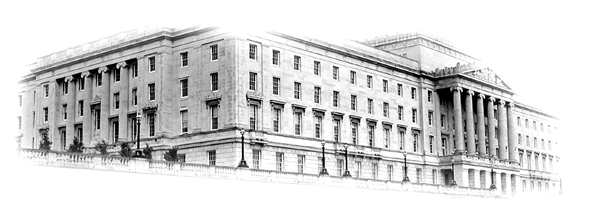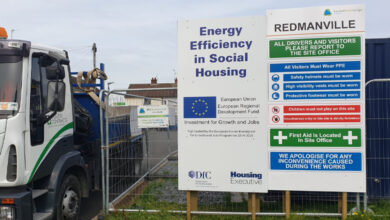Statutes: the Assembly’s legislative agenda

Stormont is entering its new term with a full legislative agenda, covering justice, the economy, welfare and range of other policy matters. agendaNi sums up the content and status of the bills before the Assembly, both from ministers and private members.
Business Improvements Districts Bill
This Bill provides for statutory business improvement districts (BIDs) and a general legislative framework for the BID scheme. Details of the scheme will be introduced through secondary legislation. The model is regarded as having the potential to improve business environments and economic growth. The legislation will allow a district council to define such a district within its council area or in co-operation with a neighbouring council. A bid will only proceed if approved through an official ballot of non-domestic rate-payers within a proposed area.
Sponsor: Social Development Minister
Stage: Committee
Charities Bill
The Bill will amend the public benefit provision of the Charities Act (Northern Ireland) 2008 to provide clarity on the requirement to be met in determining whether an institution is or is not a charity (within that Act’s meaning). It also transfers certain regulatory functions from the Department for Social Development to the Charity Commission for Northern Ireland.
Sponsor: Social Development Minister
Stage: Committee
Criminal Justice Bill
Amendments to the law relating to sex offender notification, human trafficking and sexual offences prevention orders are provided for by this Bill. Attempts to reform the sex offender notification requirements arise from a court ruling in England that the absence of a right of review of the indefinite nature of notifications breaches the right to privacy protected by Article 8 of the European Convention on Human Rights. It also provides for the destruction, retention, use and other regulation of certain fingerprints and DNA samples and profiles.
Sponsor: Justice Minister
Stage: Committee
Inquiry into Historical Institutional Abuse Bill
A judge-led inquiry into institutional abuse between 1945 and 1995 is provided for by this Bill. The inquiry will make findings and recommendations on whether there were systemic failings by the state or institutions in their duties towards children under 18 for whom they provided residential care during that time. Under inquiry will be any institution with responsibility for the care, health or welfare of children other than schools (but including a training school or borstal) that provided residential care accommodation and took decisions about and made provision for day-to-day care for children. Sponsors: First and deputy First Ministers
Stage: Committee
Marine Bill
The purpose of this Bill is to legislate for marine plans for Northern Ireland’s inshore region and marine conservation zones within that region. The legislation will establish a strategic system of marine planning and reform the licensing and enforcement regime. To protect marine biodiversity and to ensure international and EU commitments are met, the Bill seeks to contribute to the UK aim of establishing an ecologically coherent network of marine protected areas. Where a marine licence and a consent are both needed for an offshore electricity generating station, both applications will be considered together.
Sponsor: Environment Minister
Stage: Committee
Civil Service (Special Advisers) Bill
A proposal to prevent any person who has been convicted of a serious criminal offence (i.e. a custodial sentence of five years or more) from becoming a special adviser. It puts a statutory duty on DFP to publish a code of conduct and an annual report on the number and cost of special advisers, as well as a code for appointment of special advisers. The Bill followed the appointment by Sinn Féin Minister Carál Ní Chuilín of Mary McArdle as her special adviser. McArdle was convicted in 1984 for her role in the murder of Mary Travers.
Sponsor: Jim Allister (TUV)
Stage: Committee (Finance and Personnel)
Superannuation Bill
This Bill aims to remove the requirement on the Department of Finance and Personnel (DFP) to secure the consent of trade unions to introduce detrimental changes to the Civil Service Compensation Scheme. It introduces new requirements on the department to report on consultation with unions on reaching agreement on such changes. The department will also have to lay a report before the Assembly on consultation about changes to reducing payable compensation to civil servants on redundancy.
Sponsor: Finance and Personnel Minister
Stage: Committee
Duty to Co-operate Bill
The draft Bill aims to introduce a statutory duty on all relevant government departments to collaborate in the planning, commissioning and delivery of services to children in Northern Ireland. Consultation closed on 30 June.
Sponsor: Steven Agnew (Green)
Stage: Draft
Human Trafficking & Exploitation (Further Provisions and Support for Victims) Bill
This Bill proposes to allow courts to take aggravating factors into consideration when passing sentence, bring in a new offence of paying for the sexual services of a prostitute, and require training and investigative tools to be made available for police and prosecutors. Consultation closes on 18 October.
Sponsor: Lord Morrow (DUP)
Stage: Draft
Welfare Reform Bill
To implement corresponding provisions in the UK Government’s Welfare Reform Act 2012, the Bill introduces the universal credit, to replace existing in and out of work benefits. It also provides for a personal independence payment, to replace the existing disability living allowance.
Sponsor: Social Development Minister
Stage: First
Speed Limits Bill
To reduce the speed limit on urban residential streets from 30mph to 20mph (smaller residential streets but not major thoroughfares). Consultation closed on 11 June.
Sponsor: Conall McDevitt (SDLP)
Stage: Draft
Agriculture (Amendment) Bill
To reclassify the horse from a domestic to an agricultural animal. This would eliminate the need for horse owners to have to pay rates for stables. The proposed Bill, which was subject to consultation until 3 August, would allow stables to be erected without going through the planning process.
Sponsor: Sandra Overend (UUP)
Stage: Draft
Townlands Bill
Flanagan’s draft Bill aims to enable councils (if they wish) to number properties based on townlands as opposed to numerical sequencing upon streets or roads. It would also allow the townland name to be placed first in the address, followed by a street or road name. Consultation is open until 31 October.
Sponsor: Phil Flanagan (SF)
Stage: Draft





